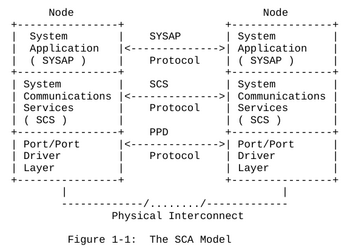Difference between revisions of "System Communication Architecture"
From Computer History Wiki
m (Better cats) |
m (Rename VAX cat) |
||
| (One intermediate revision by the same user not shown) | |||
| Line 3: | Line 3: | ||
The '''System Communication Architecture''' (given as '''Systems Communication Architecture''' in some documents) is [[Digital Equipment Corporation|DEC]]'s [[data network]]ing [[architecture]] for [[VAXcluster]] systems; it defines the major constituent [[protocol]]s, what functions each one performs, and how they interact. It allows the basic data-communication mechanism of a VAXcluster, the [[Computer Interconnect]], to be shared between the numerous functions needed to operate the VAXcluster. | The '''System Communication Architecture''' (given as '''Systems Communication Architecture''' in some documents) is [[Digital Equipment Corporation|DEC]]'s [[data network]]ing [[architecture]] for [[VAXcluster]] systems; it defines the major constituent [[protocol]]s, what functions each one performs, and how they interact. It allows the basic data-communication mechanism of a VAXcluster, the [[Computer Interconnect]], to be shared between the numerous functions needed to operate the VAXcluster. | ||
| − | The System Communication Architecture has | + | The System Communication Architecture has a three-tier model consisting of the layers (from top to bottom): |
| + | |||
* '''System Application''' (SYSAP), using the SYSAP Protocol | * '''System Application''' (SYSAP), using the SYSAP Protocol | ||
* '''System Communications Services''' (SCS), using the SCS Protocol | * '''System Communications Services''' (SCS), using the SCS Protocol | ||
| Line 11: | Line 12: | ||
The SCA architecture supports the performance of six different functions: | The SCA architecture supports the performance of six different functions: | ||
| + | |||
* Cluster configuration management | * Cluster configuration management | ||
| − | * Buffer management | + | * [[Buffer]] management |
| − | * Connection management | + | * [[Connection]] management |
| − | * Directory services | + | * [[Directory]] services |
| − | * Datagram and sequenced- message services | + | * [[Datagram]] and sequenced-message services |
* Named-buffer transfer services | * Named-buffer transfer services | ||
| Line 28: | Line 30: | ||
[[Category: DEC Networking]] | [[Category: DEC Networking]] | ||
[[Category: DEC Interface Standards]] | [[Category: DEC Interface Standards]] | ||
| − | [[Category: | + | [[Category: VAX]] |
Latest revision as of 20:18, 11 August 2024
The System Communication Architecture (given as Systems Communication Architecture in some documents) is DEC's data networking architecture for VAXcluster systems; it defines the major constituent protocols, what functions each one performs, and how they interact. It allows the basic data-communication mechanism of a VAXcluster, the Computer Interconnect, to be shared between the numerous functions needed to operate the VAXcluster.
The System Communication Architecture has a three-tier model consisting of the layers (from top to bottom):
- System Application (SYSAP), using the SYSAP Protocol
- System Communications Services (SCS), using the SCS Protocol
- Port/Port Driver Layer, using the PPD Protocol
SCA Services
The SCA architecture supports the performance of six different functions:
- Cluster configuration management
- Buffer management
- Connection management
- Directory services
- Datagram and sequenced-message services
- Named-buffer transfer services
See the article linked below for detailed descriptions of the SCA functions.
External links
- The System Communication Architecture, in DTJ, Vol. 1 No. 5, September, 1987 (pp. 24-30 of the PDF)
